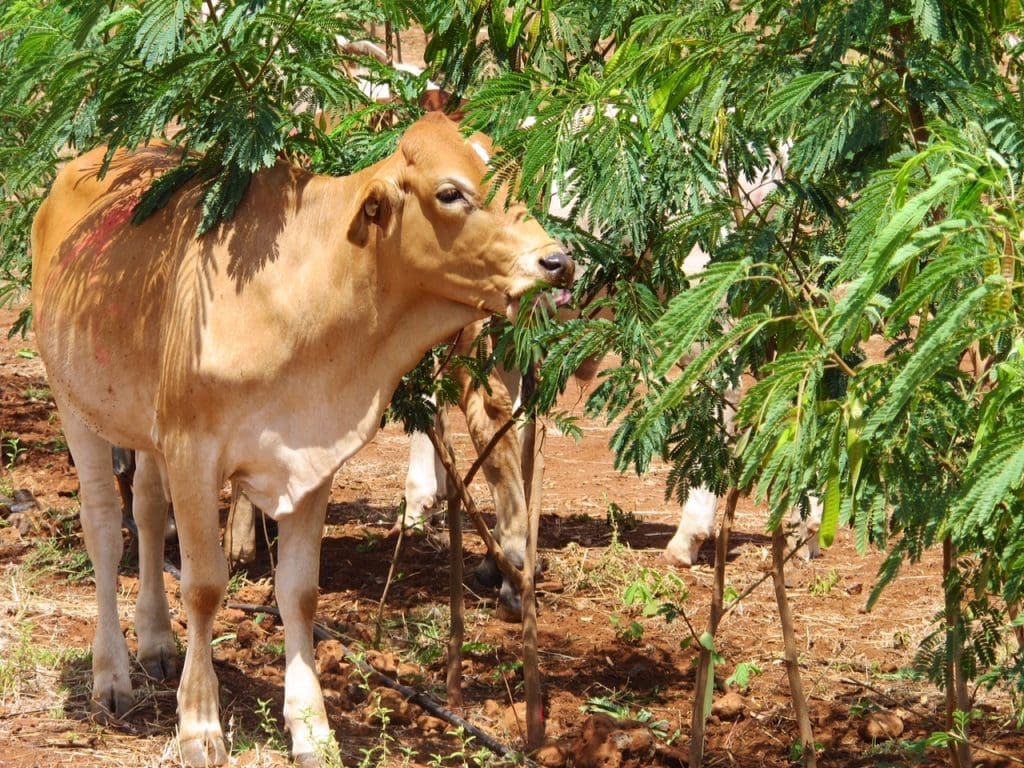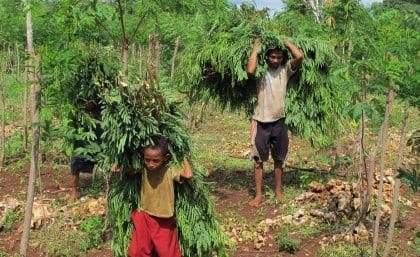Researchers Max Shelton, Graham Kerven and Michael Halliday from University of Queensland, and Scott Dalzell (Leucaena Research and Consulting, Port Macquarie) have provided this valuable update about some new findings regarding the management of leucaena toxicity….

RECENTLY there has been discussion about the rumen inoculation status of cattle grazing leucaena as a management strategy against possible toxicity.
In this article, we outline the findings of long-term University of Queensland / CSIRO studies that identified another pathway animals use to detoxify leucaena. This research raises questions regarding need to inoculate cattle grazing leucaena with the bug.
It is well known that leucaena contains mimosine, an amino acid that can cause short-term toxicity symptoms in cattle that have never before grazed leucaena.
Our concern about the ability of the rumen ‘bug’ to protect animals began in 2004 when UQ researchers sampled urine from 385 Australian cattle grazing leucaena across 36 properties (Dalzell et al. 2012).
We knew that if DHP was being fully degraded in the rumen by the ‘bug’, there should be no DHP voided in urine. However, half of all herds studied had high levels of DHP in urine. This indicated incomplete degradation despite previous inoculation or the use of alternative strategies for introducing S. jonesii to their herds (Dalzell et al. 2006).
Later pen-feeding studies with steers fed leucaena confirmed significant amounts of DHP in urine, despite inoculation with S. jonesii (Halliday et al. 2018).
We also found that the original urine test used to detect undegraded DHP greatly underestimated the amount of undegraded DHP in urine samples (Halliday 2018).
Interestingly, all the cattle tested appeared healthy with no obvious signs of toxicity. These results led us to question the role of inoculation in managing cattle grazing leucaena.
Indonesian discovery
Evidence for another pathway of detoxification was discovered when we commenced a five-year project in Eastern Indonesia in 2011 in collaboration with CSIRO researchers. The work was funded by the Australian Centre for International Agricultural Research.

Indonesian farmers gathering leucaena to be fed to non-inoculated livestock
We discovered hundreds of farmers feeding uninoculated Bali bulls (Bos javanicus) up to 100pc leucaena diets daily and animals showed no toxicity symptoms.
Not only were the Indonesian cattle free from toxicity symptoms, but they were also growing at rates close to their genetic potential (Panjaitan et al. 2014).
When questioned, Indonesian farmers reported that newly purchased cattle, naïve to leucaena, initially showed possible toxicity symptoms, such as hair loss, salivation and reduced appetite, but recovered quickly and subsequently exhibited excellent growth performance.
An Indonesian animal scientist once remarked that “leucaena is like marijuana to cattle, first they get sick then they get addicted.”
When we tested the urine of these cattle, DHP was present in very high concentrations indicating they were not degrading much of the DHP in the rumen. Almost all (>97pc) of the DHP present in urine was in what we call a conjugated (complexed) form (Halliday 2018).
The conjugating compounds (glucuronic acid and sulphate compounds) are produced by the liver and act by bonding with DHP, neutralising its toxic activity and increasing its solubility, enabling rapid excretion in urine.
In concurrent microbiological investigations, CSIRO scientists developed new PCR-based assays to improve the specificity and sensitivity of detection of S. jonesii in the rumen.
In a survey of ruminants from different countries, they found S. jonesii to be ubiquitous in all regions and herds tested rather than isolated geographically as originally thought. When detected, the bacterium was present as a minor population (<106cells/mL) in the rumen and usually comprised several genetic variants (strains) of the species (McSweeney et al. 2019).
The Indonesian cattle consuming high leucaena diets were also positive for several strains of S. jonesii (McSweeney et al. 2019), again at low population levels.
It was concluded that S. jonesii, while present, was incapable of degrading all of the dietary DHP and that conjugation by the liver (hepatic detoxification) was the major pathway for preventing DHP toxicity (Shelton et al. 2019).
Since the Indonesian animals were gaining weight at a rate close to their genetic capacity, we also concluded that inoculation with S. jonesii was not necessary.
The practical implications of our findings were that feeding of diets containing up to 100pc leucaena by Indonesian smallholders was a successful strategy, as it provided a low-cost, low-labour feed source for the productive fattening of bulls (Dahlanuddin et al 2018).
Our hypothesis
Our current hypothesis after 15 years of research into leucaena toxicity is:
While the presence of indigenous S. jonesii may be degrading DHP, the pathway of hepatic detoxification is also contributing to protection of animals on high leucaena diets.
What does this mean for Australian cattle?
We then asked the question: Is liver detoxification a significant pathway in cattle grazing leucaena in Australia? Here is the current evidence:
- jonesii was present as a minor population (<106cells/mL) in the rumen of most Australian cattle herds tested and usually comprised several genetic variants of the species. Although the indigenous nature of S. jonesii could imply animals are protected from toxicity, the relative abundance of the bacterium, potential variation in DHP-degrading ability of genetic variants of the species, and level of intake of leucaena may all influence the capacity of the resident population in the rumen to protect the animal from toxicity (McSweeney et al. 2019).
- Urine tests indicate that cattle grazing leucaena are excreting significant amounts of conjugated DHP in urine suggesting that the hepatic detoxification is a significant pathway (Dalzell et al. 2012).
- While occasional toxicity symptoms such as hair loss, salivation, and foetal abortion have been observed in naïve animals, most cattle are observed to recover quickly as they adapt to leucaena diets. This appears to occur with or without inoculation.
- Several experienced graziers have observed excellent live weight gains in cattle grazing leucaena that have never been inoculated. On the other hand, there is anecdotal evidence (O’Neill and O’Neill 2019) that foetal abortion can occur when young females in their first trimester of pregnancy, naïve to leucaena, are fed high-leucaena diets, resulting in lowered calving percentages. In contrast, high calving percentages are routinely observed in breeding herds where females have adapted to high leucaena diets (J. Schmidt and P. Larsen pers. comm.). Thus, it may be possible to avoid negative effects on herd reproduction by appropriate herd management.
What still needs to be done?
Confirmation that inoculation of cattle with S. jonesii may not be necessary removes a barrier to adoption of leucaena for feeding ruminants. Nevertheless, this hypothesis needs to be confirmed under Australian conditions by some additional studies, namely:
- An audit of total mimosine ingested and total DHP voided in urine and faeces, and the type of conjugation involved, would indicate the comparative contribution of jonesii versus hepatic detoxification of DHP.
- Possible differences in ability to neutralise leucaena toxicity among species of cattle and between other ruminant species should be tested.
- Further study is needed to clarify the effects on the reproductive performance of cattle on high leucaena diets, especially for young first calf females that may not have adapted to leucaena.
Max Shelton (University of Queensland)
Scott Dalzell (Leucaena Research and Consulting Pty Ltd. Port Macquarie UQ)
Graham Kerven (University of Queensland)
Michael Halliday (University of Queensland)
